Introduction
During this unit, we focused on communicating stories through creative writing, narrative illustration, audio production, and video. We furthered our technical communication and storytelling skills by learning apps such as Adobe Illustrator, Photoshop, Dreamweaver, Wacom Digital Drawing Pads, Avid ProTools, and we continued to use Premiere Pro.
From this unit, I learned that many parts of a story that go unnoticed by the storyteller can affect the audience’s interpretation. Subconsciously adding details and symbols into a story can change the way the audience sees the character or setting. This was especially prevalent in Film and English, where colors can easily show a character’s mood without verbally describing how they feel, but also translated into Digital Media in our Illustrator projects.
Story
In English, we began the unit by reading and analyzing the writing techniques used in George Orwell’s 1984. We focused on metaphors, imagery, dialogue, and the manipulation of language in a political context, specifically the fictional language of Newspeak from 1984. We also read Flash Fiction short stories, in order to discuss how to fit a narrative arc into a short story, and inspire the kind of story we would be writing for class and producing in our elective classes. For my story, I was inspired by heroes journeying into worlds with weird rules. I wanted to incorporate some obscure imagery, and give my story a folktale feel. My final story ended up really different than my first draft and the character I workshopped in class.
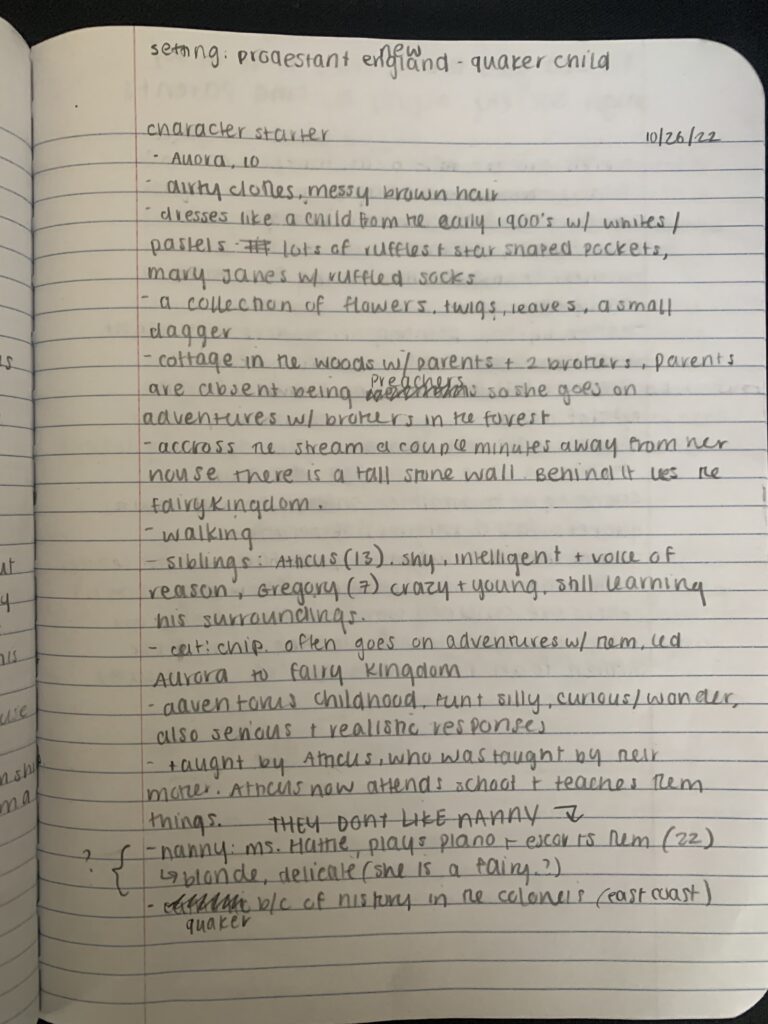
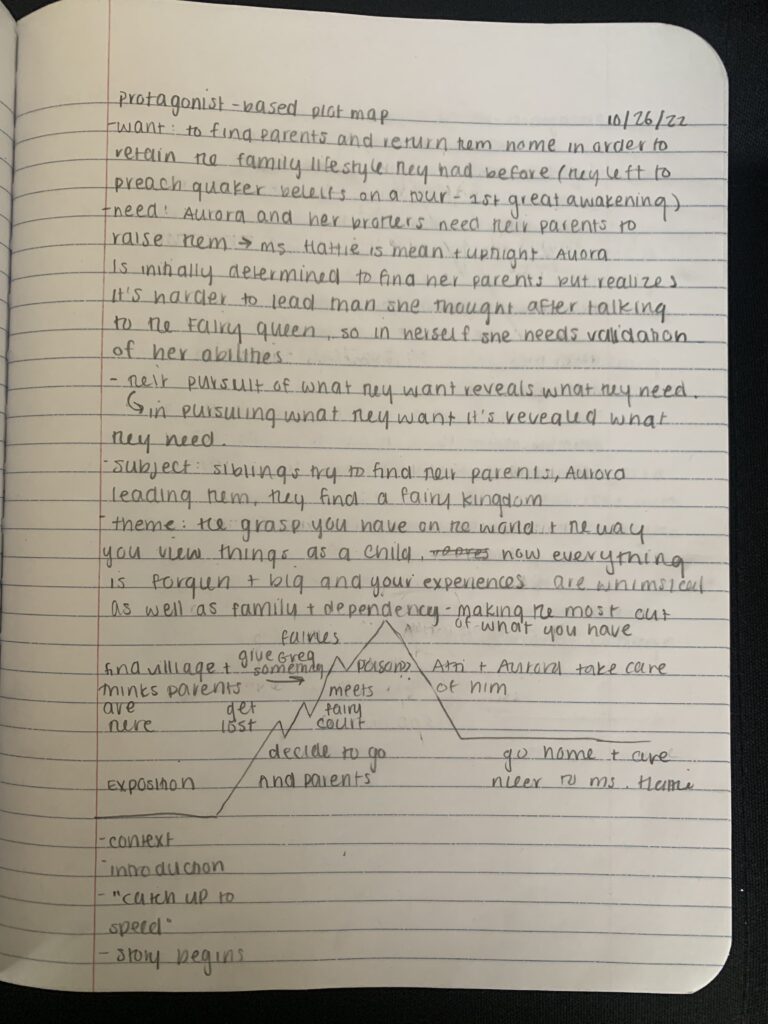
Although I didn’t end up using that story, I kept a similar main character, and doing these assignments helped me brainstorm what her story could be about. Later I became interested in how folktales use animals as symbols for human traits, like a sneaky fox, and wanted to incorporate that somehow. The final result was nothing like I’ve ever written before and I really enjoyed focusing on all aspects of creative writing, which I didn’t get to do in past English classes.
To produce the audio version, I used our Tascam recorders to record myself reading my story, and added sound effects and music in ProTools, which contributed to my audio editing and production skills for longer audio projects like podcasts and audiobooks that I could do in the future. To design the cover art, we were tasked to freely use Illustrator.
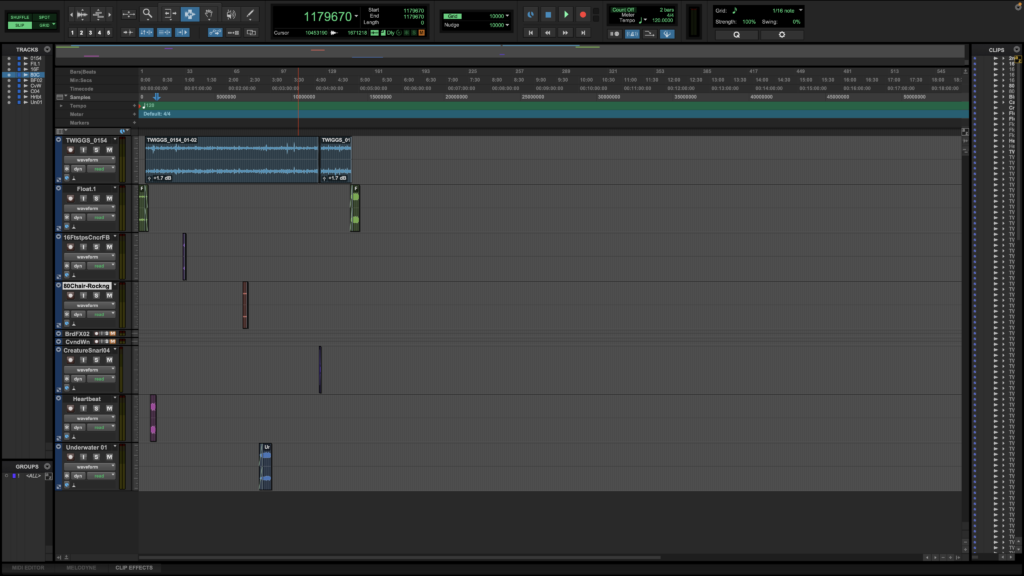
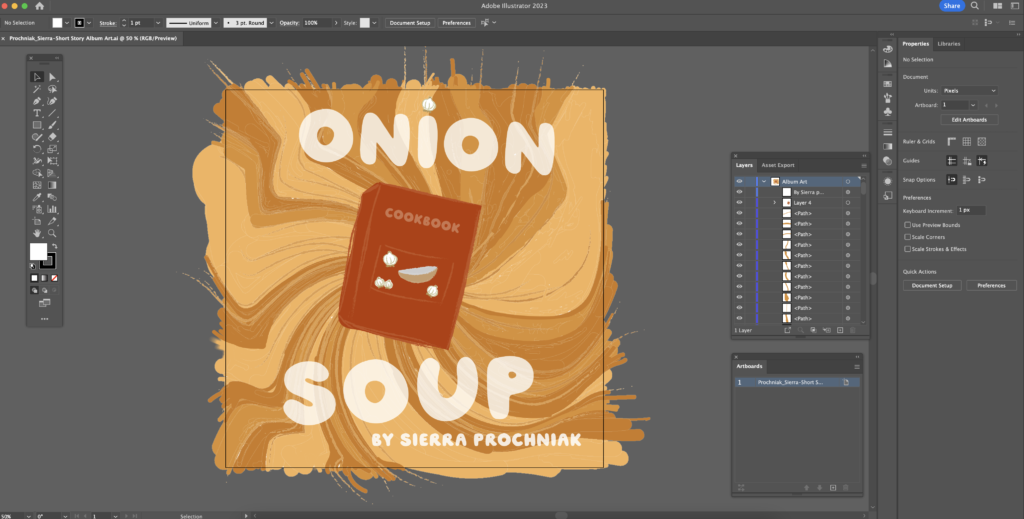
The little girl ran as fast as her small legs could take her. She knew dusk was nearing because the pastel pink in the sky was turning an inky purple, and the clouds were beginning to part and reveal the moon. She needed to capture the rabbit before it became too dark to see her own feet moving below her. It was always two paces ahead of the girl, it had been for the past ten minutes. Every time she thought she reached it, its small pale body leapt through the tall grass and out of sight. She could find it again if she squinted and searched for two white, tall, ears within the grass. She was finally getting closer, as the sun and the moon began to trade places in the sky. If she stretched her arm out as far as she possibly could, her fingertip could graze its soft tail. With all her might, she pushed her body forward, finally matching the pace of the rabbit now beside her. In a quick motion she swooped it into her arms, slowing to a halt and cradling it like a newborn. It squirmed in an attempt to escape, but relaxed its muscles as the girl took a deep breath. Animals could sense adrenaline and calm, she knew. She took another breath, lifting her hand to stroke its soft back.
Before her palm could touch the rabbit’s back, it suddenly disappeared from her clutch. In its place was a bulb of garlic. It was unnatural to cradle a bulb of garlic like a child, so the girl let it roll down her arm into her palms. Clutching it, she looked down. She knew she needed to make some food, it was dark and well past dinnertime. If only she had a cookbook! She sighed, her chest heavy with the knowledge of what she would have to do.
She pocketed the garlic and continued walking through the tall grass, forging a pathway that sealed her inside the field as she moved forward. She could hear the crickets chirping and the owls hooting beyond the field and she did not like it one bit. Her stomach churned at the thought of what lived beyond the safety of the grass wall. Thankfully, she was protected from the disquiet of the night and could trust her path was safe.
Finally, she arrived at her destination. A small clearing within the grass that could have resembled a lake, although the water was thick mud and the lounge chairs were old wooden rocking chairs. She sighed again. She did not enjoy the idea of doing this, but she knew replenishment was on the other side. Reluctantly, she dragged one of the rocking chairs by its arms so its back faced the mud. Gently, she placed herself in the chair and took a large breath in, filling her lungs and puffing up her cheeks. She leaned back, until she was sitting with her back parallel to the mud. Slowly, her feet came off the ground and the mud engulfed her. She squeezed her eyes shut, and let herself sink into the thick brown mass.
Once her whole body had sunk into the mud, she opened her eyes. What had been brown mud on the surface was underneath, a sticky, beautiful amber. She stuck out her tongue and tasted the amber that submerged her. It had worked! She was in a vat of sweet honey. She pulled herself out of the chair, slowly working against the thickness of the honey. Once standing upright, she leaned forward until her stomach was facing down, and she was in a swimming position. She knew the cookbook would be somewhere around here, she just needed to search for it.
She swam through the seemingly never-ending plain of sweet, sticky honey, keeping watch for a book of recipes. She found it after what seemed like hours of swimming. She had no idea where she had started or how to get back to the mud lake, but it was no matter. The cookbook would have the answers. She opened it, stomach grumbling. There was a single page inside, titled “Onion soup”. She smiled, pulling the onion bulb from her pocket.
Scanning the recipe, she realized there was one ingredient she couldn’t get; the hide of a rabbit. She wasn’t sure where she could find that. Frustrated, she closed the cookbook with a slam. Amber bubbles rose dispersed up into the amber from the pressure of the book. She shut her eyes, wishing there was an easier way to satisfy her hunger.
When she opened them, she was in a tall grass field and the sky was a cotton candy pink. The cookbook was in her left hand, and the onion was in her right. She blinked, confused as to how she had arrived in a field of all places.
A rustle from the patch of tall grass beside her stopped her train of thought. Seemingly out of nowhere, the grass parted and revealed a large brown bear. Shocked, she released the onion and cookbook from her grip and let them drop to the ground. Quietly, she approached the bear, trying to make slow movements. It turned its large head to face her, staring directly into her eyes. It cocked its head at her in a playful manner, and she giggled. It’s okay, it seemed to say. With a calm smile, she placed her hand on the jaw of the bear.
Slowly, the bear began to open its mouth. She jumped back. Out of the bear’s mouth, crawled a small rabbit. It hopped out of the bear’s mouth and onto the grass. The bear shut its jaw and faced the girl again as if nothing had happened. But she was not paying attention. A rabbit? What were the chances? The rabbit leapt away and out of sight, but she was determined to catch it. She began to run, pushing her little legs with all her might.
Illustrations
Throughout this unit in Digital Media, we learned how to use Adobe Illustrator to produce various group and individual projects, such as the exquisite corpse project, custom heading banners for this webpage, and an illustration of our choice to be put on an object.
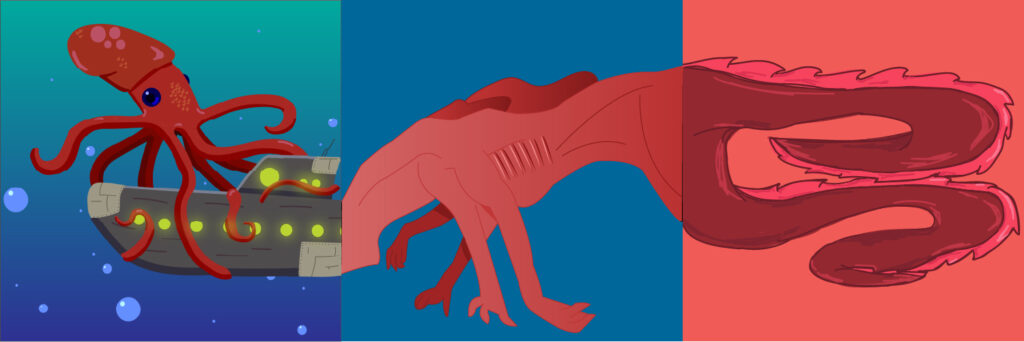
In a group of 3, we were tasked to design a panel on an illustrator file without seeing what the other group members were doing. We had parameters to follow so all the illustrations would connect at the border, but we couldn’t see anything until the final reveal.
The Junior illustrator project allowed us to combine all the tools we had been learning to create something of our choice, which could be turned into stickers, clothing art, mugs, puzzles, etc. For this project, I was inspired by the style of logos and fonts from vintage/90s graphic clothing. I wanted to create a brand name that could be put on any item of clothing, and I was inspired by my friend who was drawing a beetle to create “Blue Beetle” or “Baby Beetle”. As a backup, I found a font that fit and wrote out “New York City” a couple of different ways, to make a vintage tourist shirt.
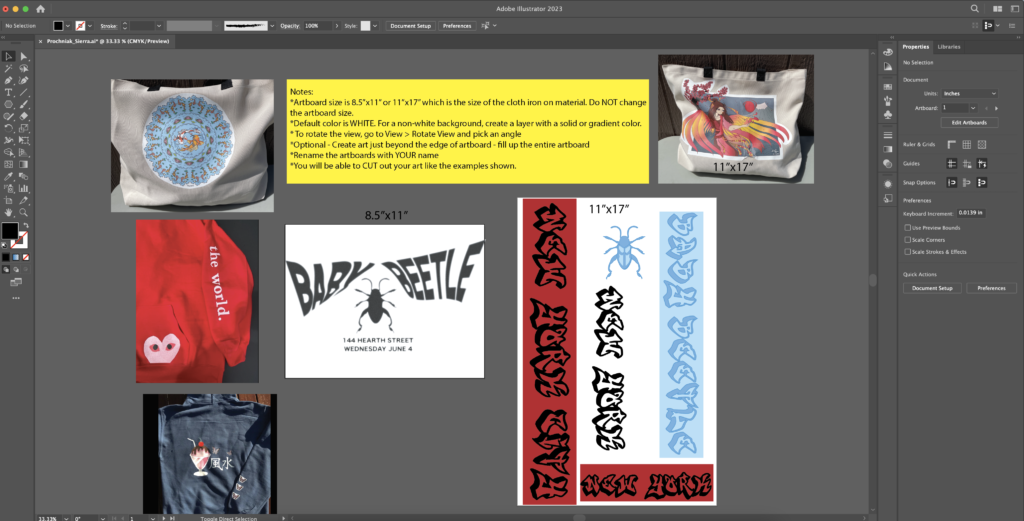
Music
Another portion of Digital Media this unit was dedicated to ProTools. Audio Production was very new to me and while it was difficult at first, I learned a lot about editing audio, equalizing clips, eliminating lyrics from songs, and more. Our first project was to mashup songs in a way that told a story, and I decided to use songs from the 20th century to tell a love story.
For our next project, our task was to pick a song, eliminate the vocals, write new lyrics, recording ourselves singing, and edit it all together in ProTools. My friend Luiza and I decided to rewrite “Tricky” by Run DMC and make it about Pete Davidson in comparison to other celebrities. I learned a lot from this project, specifically that editing music is a lot more difficult than it seems because you have to consider how the backing track lines up with the new vocals, and wether you’ve eliminated the original vocals altogether, which was a challenge for us. We recorded our song in the music shed and dressed up like rappers with sunglasses, which made the process fun and relaxed. Overall this project was really fun!
Icky (Pete Davidson’s version)
By S Money and L Money aka Sierra and Luiza
This Pete is my recital
To me he is the bible
To rock (on Pete) everyone else (delete)
It’s iiiiiiiiiicky here we go
It’s icky to think about anyone else, anyone else then Pete Davison
It’s icky icky icky
No one compares when Pete Davidson’s there, that is what I have to declare
George Clooney’s not for me, Chris Evans I must disagree
Try to find better than Pete I said it’s not that easy
It’s icky to think about anyone else, anyone else then Pete Davison
It’s icky icky icky
It’s icky to think about anyone else, anyone else then Pete Davison
It’s icky icky icky
Film
In film, we learned about film language and how to make the audience feel like they’re playing a role in the film, observing the story unfold. Narrative films often have a more fixed structure, making details—like continuity between shots, or unintentional symbolism—important. Because narrative is one of the most common genres of film, we watched many different examples to compare how other filmmakers followed the classic narrative structure. Our projects in this unit aimed to teach us visual storytelling skills that we could use for our narrative films, and other film projects in the future. First, we learned about Griffith’s pattern, the sequence of shot types you use to introduce settings and characters at the beginning of the film, invented by D.W. Griffith. Then we delved into shot types, angles, and editing techniques, and how a makeup of all 3 creates different types of scenes.
The first type of scene we were tasked to shoot was a suspense scene, which is typically made up of fast cuts between clips and uptempo music. In class, we looked at how Hitchcock employed those strategies to make some of the most famous horror movies of all time. Unfortunately, I was sick while my group filmed, so to divide up the work I was the editor. We watched these on Halloween in class to increase suspense!
Our next project was a chase scene, which aimed to combine all the techniques we had been learning about into one project. I had a lot of fun filming this and working with my parents as the actors!
Our next assignment was our first big project: a narrative short film. The project aimed to have us use the shot composition and mood skills we had already learned, and teach us even more about each step of the filmmaking process. In total, the project lasted from November to February and taught me a lot about collaboration, directing, and organization.
We began the process by writing out a synopsis of our film that we would later put into shot-by-shot storyboards with our partners. Our idea went through many rewrites, initially, the whole film took place within an escape room, as shown in our synopsis.
Filming in an escape room proved to be difficult to coordinate, so we revised our idea to then surround an ambitious tennis player, who is so obsessed with her trophy that she goes crazy and breaks it. We used this synopsis when creating our final storyboards and filming for our rough cut.
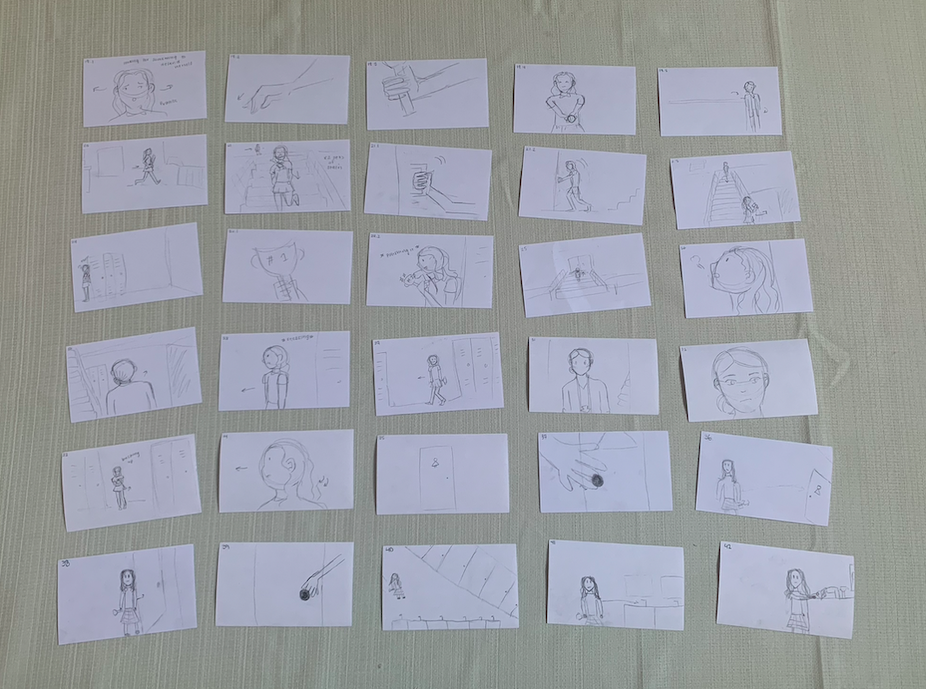
Finally, we landed on our final film being about a tennis player whose mind is so occupied by tennis that she hallucinates a giant tennis ball following her. We playfully called this film “Mind Open,” referring to the tennis term.

